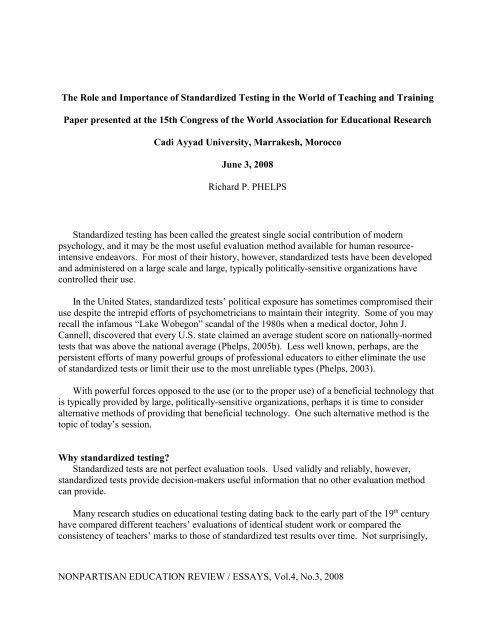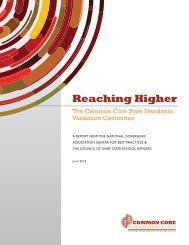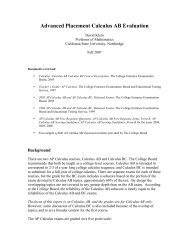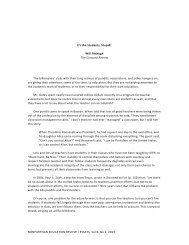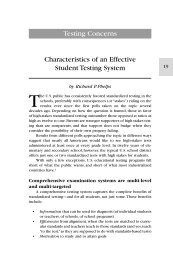Access this essay in .pdf format - Nonpartisan Education Review
Access this essay in .pdf format - Nonpartisan Education Review
Access this essay in .pdf format - Nonpartisan Education Review
You also want an ePaper? Increase the reach of your titles
YUMPU automatically turns print PDFs into web optimized ePapers that Google loves.
The Role and Importance of Standardized Test<strong>in</strong>g <strong>in</strong> the World of Teach<strong>in</strong>g and Tra<strong>in</strong><strong>in</strong>g<br />
Paper presented at the 15th Congress of the World Association for <strong>Education</strong>al Research<br />
Cadi Ayyad University, Marrakesh, Morocco<br />
June 3, 2008<br />
Richard P. PHELPS<br />
Standardized test<strong>in</strong>g has been called the greatest s<strong>in</strong>gle social contribution of modern<br />
psychology, and it may be the most useful evaluation method available for human resource<strong>in</strong>tensive<br />
endeavors. For most of their history, however, standardized tests have been developed<br />
and adm<strong>in</strong>istered on a large scale and large, typically politically-sensitive organizations have<br />
controlled their use.<br />
In the United States, standardized tests’ political exposure has sometimes compromised their<br />
use despite the <strong>in</strong>trepid efforts of psychometricians to ma<strong>in</strong>ta<strong>in</strong> their <strong>in</strong>tegrity. Some of you may<br />
recall the <strong>in</strong>famous “Lake Wobegon” scandal of the 1980s when a medical doctor, John J.<br />
Cannell, discovered that every U.S. state claimed an average student score on nationally-normed<br />
tests that was above the national average (Phelps, 2005b). Less well known, perhaps, are the<br />
persistent efforts of many powerful groups of professional educators to either elim<strong>in</strong>ate the use<br />
of standardized tests or limit their use to the most unreliable types (Phelps, 2003).<br />
With powerful forces opposed to the use (or to the proper use) of a beneficial technology that<br />
is typically provided by large, politically-sensitive organizations, perhaps it is time to consider<br />
alternative methods of provid<strong>in</strong>g that beneficial technology. One such alternative method is the<br />
topic of today’s session.<br />
Why standardized test<strong>in</strong>g<br />
Standardized tests are not perfect evaluation tools. Used validly and reliably, however,<br />
standardized tests provide decision-makers useful <strong>in</strong><strong>format</strong>ion that no other evaluation method<br />
can provide.<br />
th<br />
Many research studies on educational test<strong>in</strong>g dat<strong>in</strong>g back to the early part of the 19 century<br />
have compared different teachers’ evaluations of identical student work or compared the<br />
consistency of teachers’ marks to those of standardized test results over time. Not surpris<strong>in</strong>gly,<br />
NONPARTISAN EDUCATION REVIEW / ESSAYS, Vol.4, No.3, 2008
2 NONPARTISAN EDUCATION REVIEW / ESSAYS Vol. 4, No.3<br />
researchers found wide variance from teacher to teacher <strong>in</strong> grad<strong>in</strong>g identical student work or<br />
over time with the same teacher.<br />
In the 1910s, for example, researchers Starch and Elliott (1912) made copies of two actual<br />
English exam<strong>in</strong>ation papers and sent them to teachers to grade and return. The marks ranged<br />
from 50 to 98 percent. One paper, graded by 142 teachers, received fourteen marks below 80<br />
percent and fourteen above 94 percent. “That is, a paper which was considered too poor for a<br />
pass<strong>in</strong>g grade by some teachers was rated as excellent by others.”<br />
Starch and Elliot repeated the procedure with duplicate Geometry tests (1913). Teachers’<br />
marks on the 116 returned papers ranged from 28 to 92 percent, with twenty grades below 60<br />
percent and n<strong>in</strong>e of 85 percent and above. Accord<strong>in</strong>g to L<strong>in</strong>coln and Workman (1936, 7):<br />
This type of experiment has been repeated many times by <strong>in</strong>vestigators and always<br />
with similar results. Therefore there is abundant evidence that teachers’ marks are a<br />
very unreliable means of measurement.<br />
Without standardized tests (or standardized grad<strong>in</strong>g protocols) <strong>in</strong> education, we would<br />
<strong>in</strong>crease our reliance on <strong>in</strong>dividual teacher grad<strong>in</strong>g and test<strong>in</strong>g. Are teacher evaluations free of<br />
standardized test<strong>in</strong>g’s alleged fail<strong>in</strong>gs No. Individual teachers can narrow the curriculum to<br />
that which they prefer. Grades are susceptible to <strong>in</strong>flation with ord<strong>in</strong>ary teachers, as students get<br />
to know a teacher better and learn his idiosyncrasies. A teacher’s (or school’s) grades and test<br />
scores are far less likely to be generalizable than any standardized tests’ (See, for example,<br />
Gullickson & Ellwe<strong>in</strong>, 1985; Impara & Plake, 1996; Stigg<strong>in</strong>s, Frisbee, & Griswold, 1989;<br />
Woodruff & Ziomek, 2004a, 2004b). (In Phelps, 2008, Table 1 lists some common fallacies<br />
proffered by test<strong>in</strong>g opponents, along with citations to responsible refutations.)<br />
Accord<strong>in</strong>g to the research on the topic, many U.S teachers consider “nearly everyth<strong>in</strong>g”<br />
when assign<strong>in</strong>g marks, <strong>in</strong>clud<strong>in</strong>g student class participation, perceived effort, progress over the<br />
period of the course, and comportment, accord<strong>in</strong>g to one researcher. Actual achievement vis-àvis<br />
the subject matter is just one factor. One study of teacher grad<strong>in</strong>g practices discovered that<br />
66 percent of teachers felt that their perception of a student’s ability should be taken <strong>in</strong>to<br />
consideration <strong>in</strong> award<strong>in</strong>g the f<strong>in</strong>al grade (Frary, Cross, & Weber 1993).<br />
When <strong>in</strong>dividual teachers, or <strong>in</strong>dividual employers for that matter, are given the<br />
responsibility to make judgments unanchored by common standards or rules, those judgments<br />
tend to float freely <strong>in</strong> the currents of time, fitt<strong>in</strong>g first one context, then another, and then<br />
another. Be<strong>in</strong>g idiosyncratic to each particular, temporary context, each free-float<strong>in</strong>g evaluation<br />
result is not generalizable to any permanent context. It is a judgment that makes sense only to a<br />
particular teacher or employer at a particular po<strong>in</strong>t <strong>in</strong> time and space.<br />
When I was young, standardized tests were often called “objective tests,” which implied that<br />
teacher-made tests were “subjective.” Standardized tests’ clear separation from the <strong>in</strong>fluence of<br />
local decision-makers, be they classroom teachers or personnel managers responsible for hir<strong>in</strong>g
Phelps: The Role and Importance of Test<strong>in</strong>g 3<br />
new employees, rema<strong>in</strong>s one of their most beneficial features. The adoption of standardized<br />
university admission test<strong>in</strong>g <strong>in</strong> the United States <strong>in</strong> the mid-twentieth century, for example,<br />
helped to pave the way for m<strong>in</strong>orities who lacked the familial connections and social pedigree of<br />
wealthy WASPs (i.e., White, Anglo-Saxon Protestants).<br />
Accord<strong>in</strong>g to Professor Stephen G. Sireci (2005, 113), the bad reputation of standardized<br />
tests portrayed by some critics “is an undeserved one.” He cont<strong>in</strong>ues<br />
People accuse standardized tests of be<strong>in</strong>g unfair, biased and discrim<strong>in</strong>atory. Believe it<br />
or not, standardized tests are actually designed to promote test fairness. Standardized<br />
simply means that the test content is equivalent across adm<strong>in</strong>istrations and that the<br />
conditions under which the test is adm<strong>in</strong>istered are the same for all test takers.<br />
…Standardized tests are used to provide objective <strong>in</strong><strong>format</strong>ion. For example,<br />
employment tests are used to avoid unethical hir<strong>in</strong>g practices (e.g., nepotism, ethnic<br />
discrim<strong>in</strong>ation, etc.). If an assessment system uses tests that are not standardized, the<br />
system is likely to be unfair to many candidates.<br />
There is more to subjectivity <strong>in</strong> decision-mak<strong>in</strong>g than ethnic, racial, gender, or class bias,<br />
however. The fact is that true objectivity requires too much time to be practical <strong>in</strong> mak<strong>in</strong>g<br />
everyday decisions. Double-bl<strong>in</strong>d controlled experiments or program evaluations with random<br />
assignment require time, money, and tra<strong>in</strong>ed professional observation to monitor their progress.<br />
In our daily lives, we make judgments and decisions cont<strong>in</strong>uously. We cannot set up a<br />
controlled experiment, and wait for the results, every time we must choose which laundry<br />
detergent to purchase, where to go on vacation or, for that matter, whom to hire for a job or<br />
whom to admit to the last available place at university.<br />
The time-sav<strong>in</strong>g decision-mak<strong>in</strong>g technique we typically use to get on with our lives,<br />
th<br />
apparently, is Bayesian reason<strong>in</strong>g, named for the early 18 -century statistician Thomas Bayes.<br />
In Bayesian reason<strong>in</strong>g, we employ what relevant prior knowledge we have to each decision. We<br />
calculate the “subjective probabilities,” which are not, <strong>in</strong> the strictest mean<strong>in</strong>g of the term really<br />
“subjective.” More accurately, they are <strong>in</strong>complete probabilities that <strong>in</strong>corporate the <strong>in</strong><strong>format</strong>ion<br />
we have accumulated that is relevant to the matter at hand. That <strong>in</strong><strong>format</strong>ion may be reliable or<br />
not, verified or not, true or not. Nonetheless, until we discover a Founta<strong>in</strong> of Youth to provide<br />
us everlast<strong>in</strong>g life, we must rely on Bayesian reason<strong>in</strong>g as a time-sav<strong>in</strong>g heuristic to negotiate<br />
our lives <strong>in</strong> the short time allotted to each of us (“Bayes Rules,” 2006).<br />
Thus, a standardized test is more than an antidote to biased judgment. We need standardized<br />
tests because each of us is a prisoner of our own limited experiences and observations.<br />
Standardized tests provide an opportunity to make decisions about <strong>in</strong>dividuals that are free of<br />
subjectivity, be that subjectivity due to bias or Bayesian shortcuts. In develop<strong>in</strong>g standardized<br />
tests, tra<strong>in</strong>ed professionals collect empirical data, apply statistical benchmarks, and make<br />
detached, objective evaluations.
4 NONPARTISAN EDUCATION REVIEW / ESSAYS Vol. 4, No.3<br />
Standardized test<strong>in</strong>g: The long view<br />
Standardized tests have provided <strong>in</strong><strong>format</strong>ion for mak<strong>in</strong>g important decisions at least s<strong>in</strong>ce<br />
the first adm<strong>in</strong>istration of the Ch<strong>in</strong>ese civil service exam<strong>in</strong>ation many centuries ago (Zeng, 1999,<br />
8). The “scientific” standardized test (with statistically-calibrated score scales), however, is just<br />
a century old (Phelps, 2007b, chapter 2). The <strong>in</strong>novators responsible for the development of the<br />
scientific standardized test—e.g., B<strong>in</strong>et, Simon, Rice, Thorndike—though, likely would be<br />
amazed by the improvements made <strong>in</strong> test<strong>in</strong>g technology with<strong>in</strong> the relatively brief period<br />
s<strong>in</strong>ce—e.g., computer-adaptive test<strong>in</strong>g or open-source, Web-based platforms, such as the<br />
Exam<strong>in</strong>ation Assessment Management System (ExAMS).<br />
It would seem that test<strong>in</strong>g technology has improved over time exponentially. Test<br />
developers have <strong>in</strong>creased the complexity and technical sophistication of their product <strong>in</strong><br />
response to market and regulatory demands. Today’s standardized tests are better <strong>in</strong> most every<br />
way than their progenitors. They provide more <strong>in</strong><strong>format</strong>ion for the price, and they are more<br />
reliable, fair, and valid (when used as they are designed to be used).<br />
But, the exponential rate of improvement carries some risk. At the same time standardized<br />
tests have improved <strong>in</strong> quality and convenience, they have become more difficult for the average<br />
person or policymaker to understand. Most standardized tests adm<strong>in</strong>istered a century ago were<br />
simply larger-scale, standardized versions of an ord<strong>in</strong>ary classroom teacher’s exam<strong>in</strong>ation. In all<br />
apparent aspects, they looked familiar to the average exam<strong>in</strong>ee.<br />
Some of today’s standardized tests might seem to the average citizen or policymaker as<br />
different <strong>in</strong> character from their 100-year-old ancestors as today’s airplanes or automobiles do<br />
from their 100-year-old antecedents. Any of you who have tried <strong>in</strong> pla<strong>in</strong> language to expla<strong>in</strong> to<br />
policy makers the concepts of item response theory, differential item function<strong>in</strong>g, computeradaptive<br />
test<strong>in</strong>g, or po<strong>in</strong>t-biserial correlation will know what I mean.<br />
The comb<strong>in</strong>ation of technical complexity and the widespread use of test<strong>in</strong>g for public<br />
purposes should elicit a clear, measured, and open public discussion on test<strong>in</strong>g policy. And, I<br />
hope that it does where you live. In the United States, unfortunately, the public and<br />
policymakers are generally showered with obfuscation, mis<strong>in</strong><strong>format</strong>ion, and dis<strong>in</strong><strong>format</strong>ion.<br />
The test<strong>in</strong>g policy debate <strong>in</strong> the United States: The sound of one hand clapp<strong>in</strong>g<br />
Standardized test<strong>in</strong>g <strong>in</strong> the United States is an enigma. Arguably, the country hosts much of<br />
the world’s most advanced technical research and <strong>in</strong>novation. Yet, debates on test<strong>in</strong>g policy<br />
rema<strong>in</strong> primitive and one-sided.<br />
The late economist Mancur Olsen (1965, 1982) developed a theory to expla<strong>in</strong> the political<br />
power of “special <strong>in</strong>terests” <strong>in</strong> democratic societies. Individuals jo<strong>in</strong> groups that provide private<br />
benefits, such as protection aga<strong>in</strong>st market competition, disruptive technologies, or other<br />
challenges to the familiarity and security of the status quo like those portended by externallyimposed<br />
evaluations of performance, such as standardized tests. While the benefits to members
Phelps: The Role and Importance of Test<strong>in</strong>g 5<br />
of the group (e.g., a professional association of educators) can be large (e.g., the absence of<br />
standardized test<strong>in</strong>g programs) the costs (e.g., lowered student achievement, a less efficient<br />
education or employment system) tend to be diffused over society at large and may not even be<br />
noticed by those who bear them. Special <strong>in</strong>terests accrete more and more private benefits (and<br />
political power) over time, however, until they become “vested” <strong>in</strong>terests—wealthy, powerful,<br />
and entrenched.<br />
Olson’s theory is particularly applicable to education <strong>in</strong> the United States, because its<br />
governance is so widely dispersed. Each of the 50 states is constitutionally responsible for<br />
public education and, <strong>in</strong> 49 states, some governance and tax<strong>in</strong>g authority is further deferred to<br />
local school districts, which are typically governed separately from other local units of<br />
government. Some national associations of educators ma<strong>in</strong>ta<strong>in</strong> substantial memberships <strong>in</strong> each<br />
and every local school district, state legislative district, U.S. congressional district, and<br />
television, radio, and newspaper media market. They can saturate the country with the policyrelated<br />
<strong>in</strong><strong>format</strong>ion they prefer and block out the <strong>in</strong><strong>format</strong>ion dissem<strong>in</strong>ation efforts of less<br />
powerful <strong>in</strong>dividuals or groups that offer contrary po<strong>in</strong>ts of view.<br />
In the United States, society’s understand<strong>in</strong>g of standardized test<strong>in</strong>g may be shr<strong>in</strong>k<strong>in</strong>g. The<br />
technical psychometric research literature would seem to be safe. But, the research literature<br />
related to test<strong>in</strong>g policy (i.e., its adm<strong>in</strong>istration, program structure, use, extent, effects, cost,<br />
benefits, public op<strong>in</strong>ion, research dissem<strong>in</strong>ation) is dim<strong>in</strong>ish<strong>in</strong>g. There are simply too few who<br />
cite the research literature <strong>in</strong> any substantial depth or breadth, and too many will<strong>in</strong>g to declare it<br />
barren.<br />
The most common debat<strong>in</strong>g tactic of test<strong>in</strong>g opponents is to avoid debate (Phelps, 2007a).<br />
Whereas scientists seek the scrut<strong>in</strong>y of their peers <strong>in</strong> order to confirm (or deny) the value of their<br />
work, advocates tend to avoid scrut<strong>in</strong>y, especially when sell<strong>in</strong>g falsehoods. Scientists do not<br />
circumvent the research literature, but engage it. They respond to rival hypotheses with<br />
counterevidence. They confront conflict<strong>in</strong>g scientific results. Advocates, however, simply<br />
ignore them. The easiest way to w<strong>in</strong> a debate is by not <strong>in</strong>vit<strong>in</strong>g an opponent. Test<strong>in</strong>g critics<br />
rightly fear an open, fair scientific contest.<br />
Indeed, it has become quite common for test<strong>in</strong>g opponents to declare nonexistent an<br />
enormous research literature that contradicts their claims. With the help of the fourth estate<br />
(Lieberman, 2007, chapter 11), they have been fairly successful <strong>in</strong> eradicat<strong>in</strong>g from the<br />
collective memory thousands of studies conducted by earnest researchers over the course of a<br />
century.<br />
In one effort of m<strong>in</strong>e—accumulat<strong>in</strong>g studies on the effects of standardized test<strong>in</strong>g—I started<br />
out th<strong>in</strong>k<strong>in</strong>g that there were a dozen or so. A few years ago I knew that there were hundreds.<br />
Now I know that their number exceeds a thousand. (In Phelps, 2008, Table 2 provides a brief<br />
synopsis of the research literature.)
6 NONPARTISAN EDUCATION REVIEW / ESSAYS Vol. 4, No.3<br />
In the end, however, it will not matter for society’s sake if we f<strong>in</strong>d ten thousand studies.<br />
There will rema<strong>in</strong> other education researchers, prom<strong>in</strong>ent and with hugely abundant resources at<br />
their disposal—researchers whose work is frequently covered by U.S. education<br />
journalists—who will cont<strong>in</strong>ue to <strong>in</strong>sist that no such studies ever existed. It is U.S. education<br />
research’s dirty big secret: research that generates results that are unpopular among the vested<br />
<strong>in</strong>terests can be successfully—and easily—censored and suppressed (see, for example, Phelps,<br />
1999; 2000; 2003, Preface & chapter 7; 2005a, chapter 3).<br />
Wildlife conservationists tell us that a biological species cannot survive when mat<strong>in</strong>g<br />
<strong>in</strong>dividuals cannot f<strong>in</strong>d each other. When numbers decl<strong>in</strong>e to such an extent that predators (or<br />
hunters) can more easily f<strong>in</strong>d members of the species than can potential mates, the species<br />
crosses a demographic threshold and heads toward its <strong>in</strong>evitable ext<strong>in</strong>ction. Those who work<br />
with endangered species call <strong>this</strong> the “ext<strong>in</strong>ction vortex.”<br />
Similarly, the censorship and suppression of the research literature on the effects of<br />
educational achievement test<strong>in</strong>g has become so successful that it has become difficult to f<strong>in</strong>d its<br />
progenitors. For example, I may have spent more time than anyone comb<strong>in</strong>g the research<br />
literature. Nonetheless, I was a few years <strong>in</strong>to my effort before I discovered the work of Frank<br />
Dempster (1991, 1997), one of the world’s foremost authorities, or that of Jim Haynie who<br />
works <strong>in</strong> career and technical education. Why did it take me so long to f<strong>in</strong>d their work Their<br />
work is not popular among the vested <strong>in</strong>terests <strong>in</strong> education—they f<strong>in</strong>d the benefits of test<strong>in</strong>g to<br />
be strong and persistent—thus it is not widely advertised.<br />
One hundred years of research and experience left beh<strong>in</strong>d<br />
Indeed, the No Child Left Beh<strong>in</strong>d (NCLB) Act, passed by the U.S. Congress <strong>in</strong> 2002, could<br />
have been <strong>in</strong>formed by a cornucopia of research and experience. Instead, it was <strong>in</strong>formed by<br />
virtually none. Prior research and experience would have told policymakers that most of the<br />
motivational benefits of standardized tests required consequences for the students and not just<br />
for the schools. Those stakes needn’t be very high to be effective, but there must be some. As<br />
NCLB imposes stakes on schools, but not on students, who knows if the students even try to<br />
perform well.<br />
Prior research and experience would have <strong>in</strong>formed policymakers that educators are<br />
<strong>in</strong>telligent people who respond to <strong>in</strong>centives, and who will game a system if they are given an<br />
opportunity to do so (see, for example, Cannell, 1987, 1989). The NCLB Act left many aspects<br />
of the test adm<strong>in</strong>istration process that profoundly affect scores (e.g., <strong>in</strong>centives and motivation,<br />
cut scores, degree of curricular alignment) up for grabs and open to manipulation by local and<br />
state officials.<br />
Prior research and experience would have <strong>in</strong>formed policymakers that different tests get<br />
different results and one should not expect average scores from different tests to rise and fall <strong>in</strong><br />
unison over time (as some <strong>in</strong>terpreters of the NCLB Act seem to expect with the National<br />
Assessment of <strong>Education</strong>al Progress [NAEP] benchmark) (Phelps, 2005b).
Phelps: The Role and Importance of Test<strong>in</strong>g 7<br />
Prior research and experience would have <strong>in</strong>formed policymakers that the public was not <strong>in</strong><br />
favor of punish<strong>in</strong>g poorly-perform<strong>in</strong>g schools (as NCLB does), but was <strong>in</strong> favor of apply<strong>in</strong>g<br />
consequences to poorly-perform<strong>in</strong>g students and teachers (which NCLB does not) (see, for<br />
example, Phelps 2005a, chapter 1).<br />
What are the effects of test-based accountability Table 3 <strong>in</strong> chapter 3 of the forthcom<strong>in</strong>g<br />
Correct<strong>in</strong>g fallacies about educational and psychological test<strong>in</strong>g (Phelps, 2008) lists just a small<br />
sample of useful, <strong>in</strong>sightful, relevant studies that effectively answered <strong>this</strong> question, could have<br />
<strong>in</strong>formed the design of NCLB, and have been declared by prom<strong>in</strong>ent educators to not exist.<br />
Had the policymakers and planners <strong>in</strong>volved <strong>in</strong> design<strong>in</strong>g the NCLB Act simply read the<br />
freely-available research literature <strong>in</strong>stead of fund<strong>in</strong>g expensive new studies and wait<strong>in</strong>g for their<br />
few results, they would have received more value for their money, gotten more and better<br />
<strong>in</strong><strong>format</strong>ion, and gotten it earlier when they actually needed it.<br />
With the s<strong>in</strong>gle exception of the federal mandate, there was no aspect of the NCLB<br />
accountability <strong>in</strong>itiative that had not been tried and studied before. Every one of the NCLB<br />
Act’s fail<strong>in</strong>gs was perfectly predictable, based on decades of prior experience and research.<br />
Moreover, there were better alternatives for every characteristic of the program that had also<br />
been tried and studied thoroughly by researchers <strong>in</strong> psychology, education, and program<br />
evaluation. Yet, policymakers were made aware of none of then.<br />
The result<strong>in</strong>g scantily-<strong>in</strong>formed public policy <strong>in</strong>cludes a national test<strong>in</strong>g program that would<br />
hardly be recognizable anywhere outside of North America. The standardized test<strong>in</strong>g<br />
component of NCLB <strong>in</strong>cludes no consequences for the students. This sends the sublim<strong>in</strong>al<br />
message to the students that they need not work very hard and the test<strong>in</strong>g’s largest potential<br />
benefit—motivation—is not even accrued.<br />
By contrast, schools are held accountable for students’ test performance; they are held<br />
responsible for the behavior of other human be<strong>in</strong>gs over whom they have little control.<br />
Moreover, the most important potential supporters of test<strong>in</strong>g programs—classroom teachers and<br />
school adm<strong>in</strong>istrators—are alienated, put <strong>in</strong>to the demean<strong>in</strong>g position of cajol<strong>in</strong>g students to<br />
cooperate.<br />
Tak<strong>in</strong>g test<strong>in</strong>g directly to the people<br />
I <strong>in</strong>terpret the highly successful censorship and suppression of a century’s research literature<br />
on the effects of standardized test<strong>in</strong>g to be evidence that the vested <strong>in</strong>terests <strong>in</strong> U.S. education<br />
now control the test<strong>in</strong>g policy debate. This is lamentable; but what does it have to do with<br />
today’s topic<br />
Quite a lot, as it turns out. When the forces of censorship and suppression ga<strong>in</strong> effective<br />
control of the ma<strong>in</strong> routes of <strong>in</strong><strong>format</strong>ion dissem<strong>in</strong>ation, the only way for others to reach the
8 NONPARTISAN EDUCATION REVIEW / ESSAYS Vol. 4, No.3<br />
public is via alternative routes. Where entrenched <strong>in</strong>terests attempt to impede communication<br />
between test<strong>in</strong>g producers and test<strong>in</strong>g consumers, it is only natural that the two <strong>in</strong>terested parties<br />
should try to communicate directly. And, that is where the <strong>in</strong>novation of Web-based opensource<br />
platforms fits <strong>in</strong>.<br />
Hopefully, Web-based open-source test<strong>in</strong>g platforms will not only facilitate the spread of<br />
high-quality test<strong>in</strong>g use but also its understand<strong>in</strong>g. As more and more test users learn how to use<br />
the technology they simultaneously become better <strong>in</strong>formed citizens not only about a technology<br />
but about public policies related to test<strong>in</strong>g.<br />
References<br />
Bayes Rules. (2006, January 5). The Economist. Retrieved April 27, 2008 from<br />
http://www.economist.com/science/displaystory.cfmstory_id=E1_VPVQGJG<br />
Cannell, J.J. (1987). Nationally normed elementary achievement test<strong>in</strong>g <strong>in</strong> America’s public<br />
nd<br />
schools: How all fifty state are above the national average. (2 Ed.), Daniels, WV, USA:<br />
Friends for <strong>Education</strong>.<br />
Cannell, J.J. (1989). How public educators cheat on standardized achievement tests.<br />
Albuquerque, NM, USA: Friends for <strong>Education</strong>.<br />
Dempster, F. N. (1991, April). Synthesis of research on reviews and tests, <strong>Education</strong>al<br />
Leadership, 71–76.<br />
Dempster, F. N. (1997). Us<strong>in</strong>g tests to promote classroom learn<strong>in</strong>g. (pp. 332–346). In R. F.<br />
Dillon, (Ed.). Handbook on test<strong>in</strong>g. Westport, CT, USA: Greenwood Press.<br />
Frary, R. B., Cross, L. H., & Weber, L. J. (1993). Test<strong>in</strong>g and grad<strong>in</strong>g practices and op<strong>in</strong>ions of<br />
secondary school teachers of academic subjects: Implications for <strong>in</strong>struction <strong>in</strong> measurement,<br />
<strong>Education</strong>al Measurement: Issues and Practice, 12(3), 23+.<br />
Gullickson, A.R. & Ellwe<strong>in</strong>, M. C. (1985). Post-hoc analysis of teacher-made tests: The<br />
goodness of fit between prescription and practice. <strong>Education</strong>al Measurement: Issues and<br />
Practice, 4(1), 15–18.<br />
Impara, J. C. & Plake, B. S. (1996). Professional development <strong>in</strong> student assessment for<br />
educational adm<strong>in</strong>istrators. <strong>Education</strong>al Measurement: Issues and Practice, 15(2), 14–20.<br />
Lieberman, M. (2007). The educational morass. Lanham, MD, USA: Rowman & Littlefield.<br />
L<strong>in</strong>coln, E. A., & Workman, L. L. (1936). Test<strong>in</strong>g and the uses of test results. New York, NY,<br />
USA: Macmillan.<br />
Olson, M. (1965). The logic of collective action: Public goods and the theory of groups,<br />
Cambridge, MA, USA: Harvard University Press.<br />
Olson, M. (1982). The rise and decl<strong>in</strong>e of nations: Economic growth, stagflation, and social<br />
rigidities, New Haven, CT, USA: Yale University Press.<br />
Phelps, R. P., (1999, April). <strong>Education</strong> establishment bias A look at the National Research<br />
Council’s critique of test utility studies, The Industrial-Organizational Psychologist, 36(4),<br />
37–49.<br />
Phelps, R. P. (2000, W<strong>in</strong>ter). Estimat<strong>in</strong>g the cost of systemwide student test<strong>in</strong>g <strong>in</strong> the United<br />
States. Journal of <strong>Education</strong> F<strong>in</strong>ance, 343–380.
Phelps: The Role and Importance of Test<strong>in</strong>g 9<br />
Phelps, R. P. (2003). Kill the messenger: The war on standardized test<strong>in</strong>g. New Brunswick, NJ,<br />
USA: Transaction Publishers.<br />
Phelps, R. P., Ed. (2005a). Defend<strong>in</strong>g standardized test<strong>in</strong>g. Mahwah, NJ, USA: Lawrence<br />
Erlbaum.<br />
Phelps, R.P. (2005b). The source of Lake Wobegon. <strong>Nonpartisan</strong> <strong>Education</strong> <strong>Review</strong> / Articles,<br />
1(2). Retrievable at http://www.npe.ednews.org/<strong>Review</strong> /Articles/v1n2.htm<br />
Phelps, R.P. (2007a). The dissolution of education knowledge. <strong>Education</strong>al Horizons, 85(4),<br />
232–247.<br />
Phelps, R.P. (2007b). Standardized test<strong>in</strong>g primer. New York, NY, USA: Peter Lang.<br />
Phelps, R.P. (2008). <strong>Education</strong>al achievement test<strong>in</strong>g fallacies, Chapter 3 <strong>in</strong> R.P. Phelps (Ed.),<br />
Correct<strong>in</strong>g fallacies about educational and psychological test<strong>in</strong>g. Wash<strong>in</strong>gton, DC, USA:<br />
American Psychological Association.<br />
Sireci, S. G. (2005). The most frequently unasked questions about test<strong>in</strong>g. In R. P. Phelps (Ed.).<br />
Defend<strong>in</strong>g standardized test<strong>in</strong>g (111–122). Mahwah, NJ, USA: Lawrence Erlbaum.<br />
Starch, D., & Elliot, E. C. (1912). Reliability of the grad<strong>in</strong>g of high school work <strong>in</strong> English.<br />
School <strong>Review</strong>, 21, 442–457.<br />
Starch, D., & Elliot, E. C. (1913). Reliability of grad<strong>in</strong>g work <strong>in</strong> mathematics. School <strong>Review</strong>,<br />
22, 254–259.<br />
Stigg<strong>in</strong>s, R. J., Frisbee, D. A. & Griswold, P. A. (1989). Inside high school grad<strong>in</strong>g practices:<br />
Build<strong>in</strong>g a research agenda, <strong>Education</strong>al Measurement: Issues and Practice. 8(2), 5–14.<br />
Woodruff, D. J., & Ziomek, R. L. (2004a, March). Differential grad<strong>in</strong>g standards among high<br />
schools. ACT Research Report 2004-2, Iowa City, IA, USA: ACT.<br />
Woodruff, D. J., & Ziomek, R. L. (2004b, March). High School Grade Inflation from 1991 to<br />
2003. ACT Research Report 2004-4, Iowa City, IA, USA: ACT.<br />
Zeng, K. (1999). Dragon gate: Competitive exam<strong>in</strong>ations and their consequences. London, UK:<br />
Cassell.


